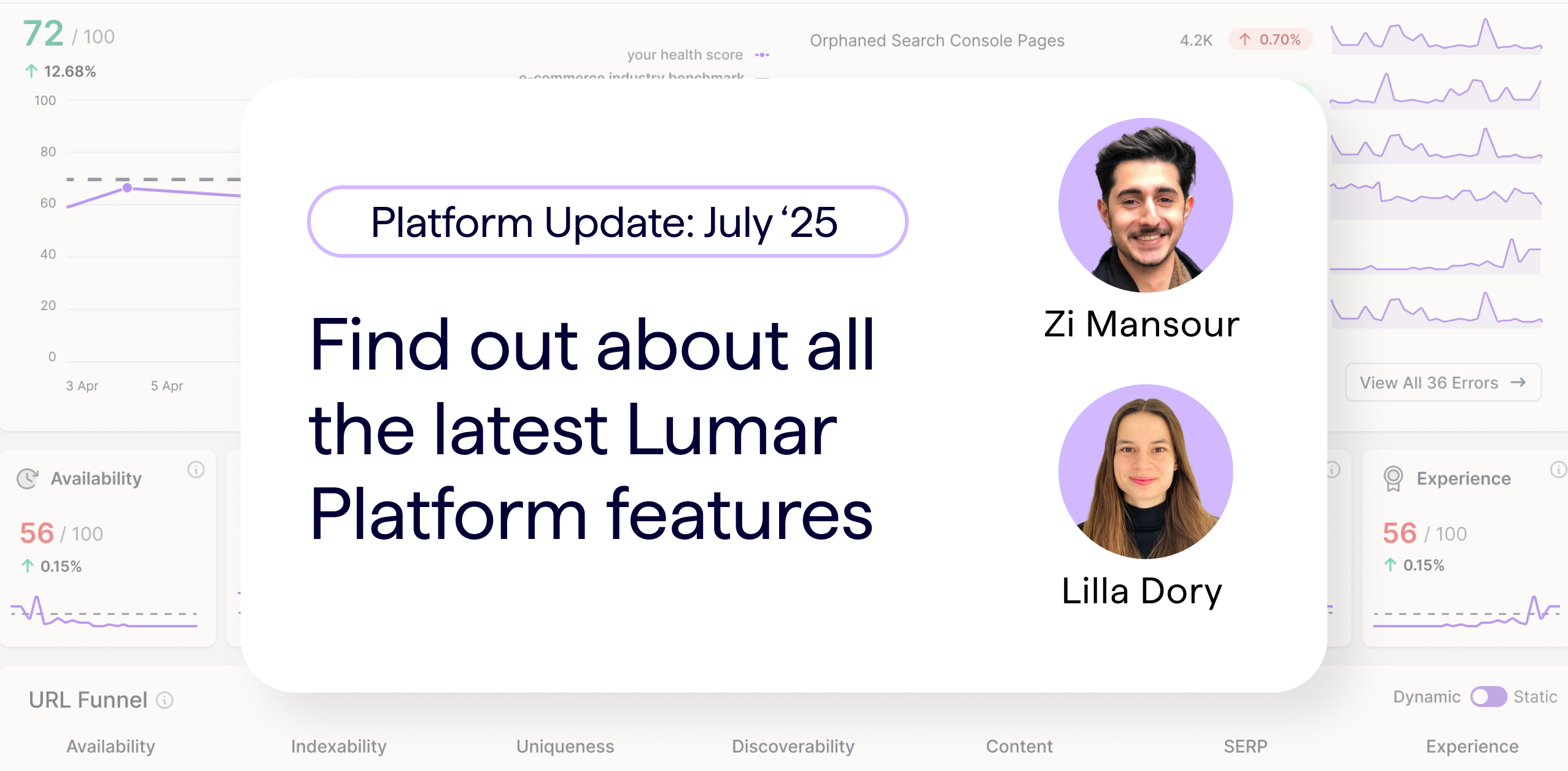Watch Now: International Website Optimization
Learn international SEO and website optimization tactics from Sophie Gibson, Technical SEO Director at StudioHawk, and host Rachael Powell, Senior Technical SEO on Lumar’s Professional Services team.
This in-depth session will help you ensure your global website is poised to generate worldwide success.
Watch the entire webinar session (including Q&A portion) on-demand above, or read on for our top takeaways.
International website strategy considerations
Gibson highlights that Google relies on a number of different signals to determine which language version of your site will be shown to a particular user.
These include:
- Technical signals like hreflang tags or domain extensions.
- Content signals like language and currency.
- Off-page signals like links from local websites or Google My Business data.
“Hreflang is not necessarily the be-all and end-all of international SEO,” Gibson says. “It is a part of it. And it is a big technical point.”
Alongside technical signals like hreflang and domain extensions, site owners need to be mindful of the international content and off-page signals as well.
Business decisions for international website projects
With this in mind, putting a strategy together for international websites needs to start with a business decision. To get started with website internationalization, ask yourself:
- Do you require separate websites due to warehousing or tax reasons?
- Do you want to sell in a market that is unlikely to convert from English-language content?
- Do you have the resources required to localize the entire site’s content and transcreate this?
It is crucial for SEOs to be part of the conversation from as early on in the process as possible, says Gibson.
Gibson advises SEOs to join planning calls — get clear on which international markets the business is looking to move into — and get clear on the ‘how’ and ‘when’ of the plan.
SEOs must work closely with developers on website internationalization
SEOs also need to work closely with web developers throughout your international expansion to help spot potential implementation issues and to check how devs plan on getting website visitors to the correct country.
The hard truth is: SEO isn’t always at the forefront of developers’ minds. .
“Joining in on the planning and moving forward on the technical conversations that are happening during this process is really important,” Gibson says.
Where defaults with redirects are concerned, being part of the conversation puts SEOs in a helpful position to be able to offer guidance as they are implemented so they can be configured correctly at the outset. This minimizes the risk of problems down the line.
“If something is wrong on the set-up, it might take a while for you to see an impact in rankings,” Gibson says. “And that gap can really affect traffic and the business itself.”
Content considerations for international websites
Expansion locations must be picked with care. Gibson notes that duplicate content issues can often arise from brands simply creating pages for every language/market with little strategy in place.
“If you’ve already gained traction and brand awareness in a specific country, it would make sense to be able to go to market with one or two top markets,” she says.
Likewise, if the business goal is to target certain market(s), begin by looking at the keyword opportunities there to prioritize.
“What’s the actual search opportunity?” Gibson asks. “Is it worth putting the extra time into creating a Spanish language version, for example? Is there enough search demand for your product category/area within that country in order to make it worth all of the translation and localization work you might need to do for that?”
Once new markets are selected, we then need to ask what will be different per location:
- Price/currency?
- Product/availability?
- Key page information?
For example, an accountancy website will require different information for selling in the US compared to Europe. And the more differences between the content, the more it makes sense to create a new version of the site for that.
Gibson warns: “If you don’t have enough concrete differences in content, think twice before creating a separate version.”
The best way the structure your international website versions
There are a number of options when it comes to structuring your international websites, says Gibson.
Country code top-level domains (ccTLDs)
Country code top-level domains (ccTLDs), such as ‘.co.uk’, ‘.fr’, ‘.es’ are useful for specific country and language targeting and have that larger market signal.
But these do require the management of multiple site versions. And whether you can acquire them depends on the domain name being available.
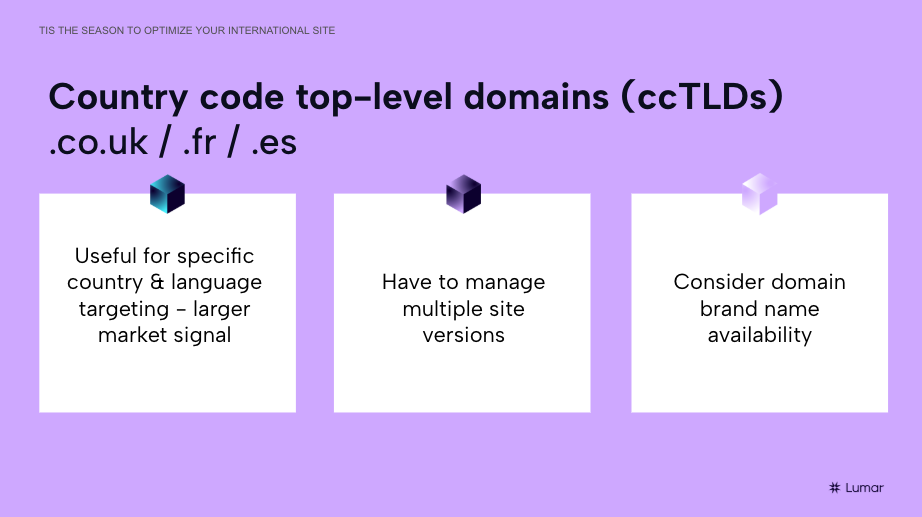
International subdomains on your top-level domain
A second option is building subdomains on a generic top-level domain (eg. ‘fr.site.com’).
These might be better suited for markets where users don’t like buying from non-local domains — but they would be classed as a separate site by Google, so they wouldn’t inherit equity from your main site.
Gibson points out that only one domain is required here (however, a ‘.com’ might be harder to acquire) and it also lays a path for further easy expansion to other markets in the future.
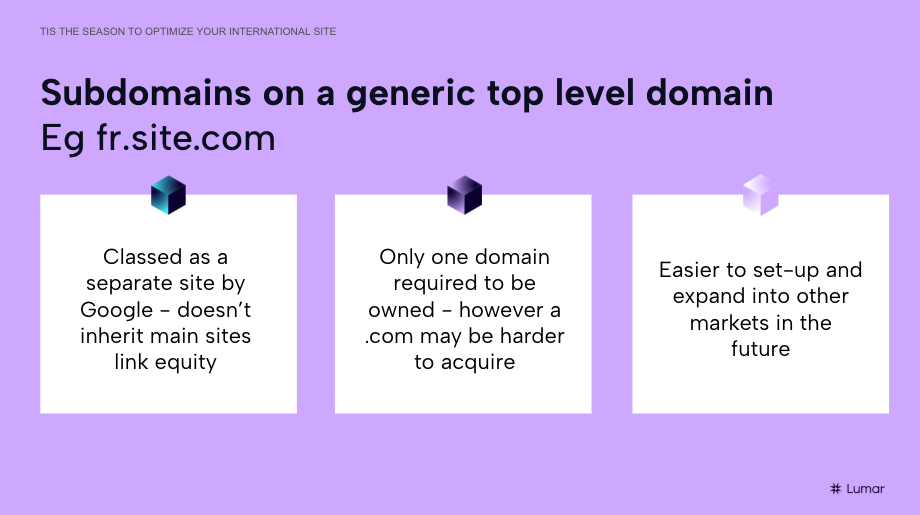
International subfolders on your generic top-level domain (gTLDs)
The third option is to use subfolders on a generic top-level domain (gTLDs) such as ‘.com/fr-fr/’ or ‘.com/es/’.
These do eliminate that country domain signal and so need more language and country targeting signals. But again, only one domain is needed and it is easy for further expansion down the line.
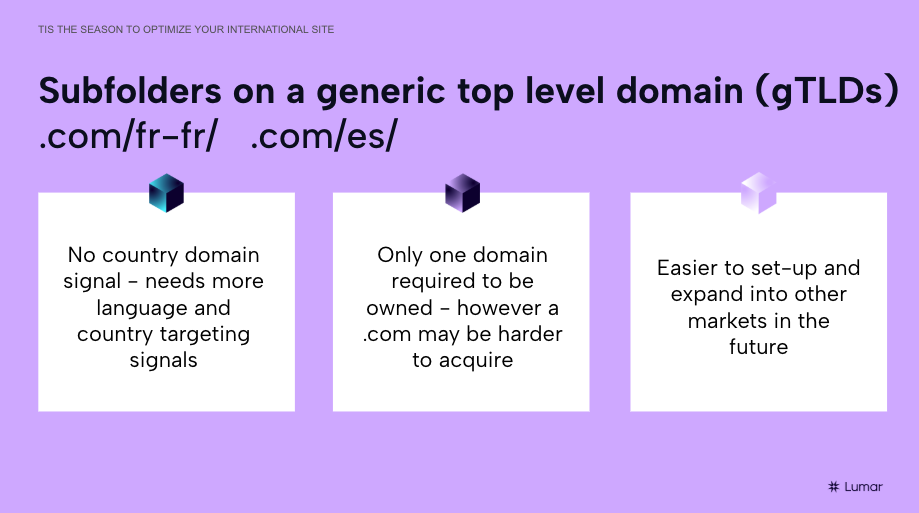
Regardless of which international website structure you choose, Gibson says you’ll need to ensure there is unique meta data on these pages to differentiate them from your original site content and help you avoid duplicate content issues.
Here are some examples provided by Gibson:
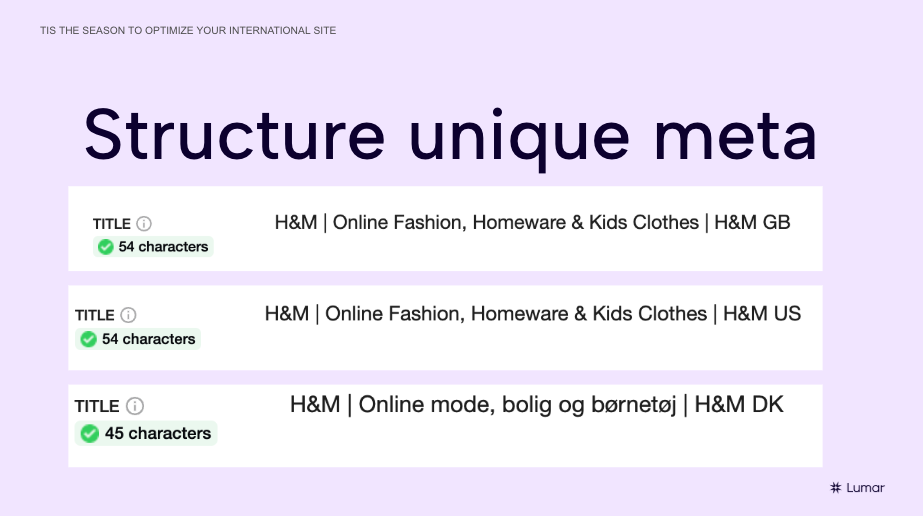
For same-language sites in different countries, you may want to add a country identifier at the end of your meta title, for example, “H&M US” or “H&M GB” — for pages in different languages, the meta title should also be in that language.
Dos and Don’ts for international website optimization
Don’t…
Add hreflang markup for every single country possible. According to Gibson, this just creates a massive amount of extra pages and duplicate content.
Don’t…
Use AI to automatically translate your whole site. “Just because you can, doesn’t mean you should,” Gibson says. Again, it can create hundreds of pages and with that increases the risk of duplicate content.
Do…
Get a professional translator to localize your website content. Rather than depending on AI, find someone who actually understands the market, the trends that are happening there, and the nuances of the language.
Do…
Consider market demand before setting up a new site version.
Don’t…
Force redirects on users via GeoIP. This can end up being a big redirect trap.
Do…
Give users a choice when they arrive on site. This provides a better user experience.
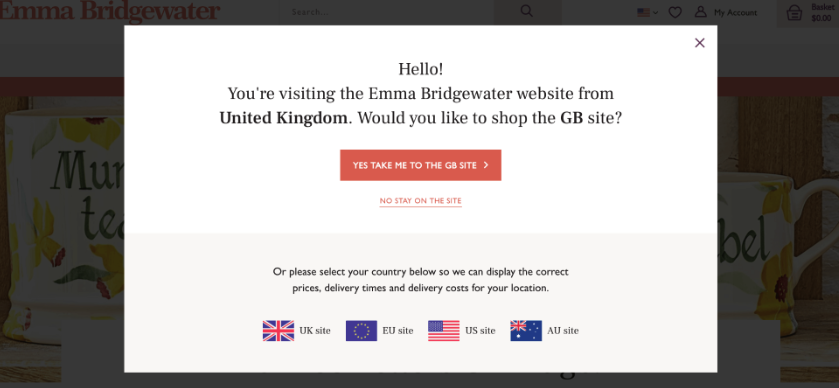
Forced redirects’ impact on SEO
Gibson reminds us that forced redirects can impact SEO results. In her example below, using GeoIP to force users to a US version of the site drastically cut visibility in Google.
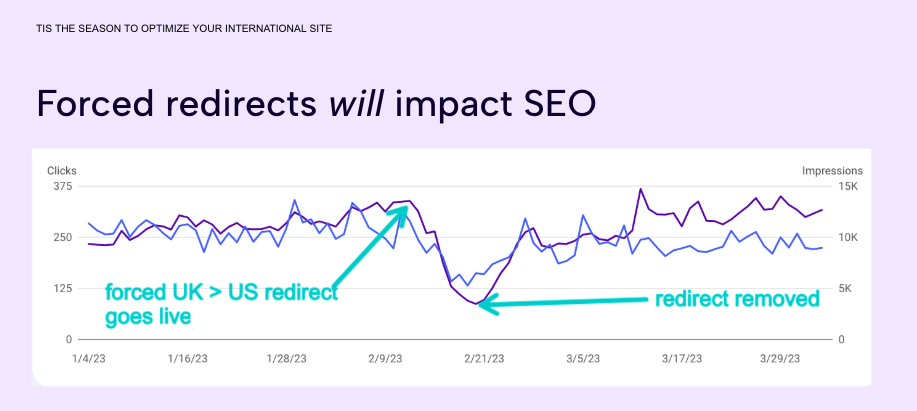
Once the redirect was removed from this page, the rankings recovered fairly quickly.
Gibson advises that we make sure Googlebot can access all versions of the site.
She suggests checking your IP redirection setup and using a VPN to spot-check this once it goes live. She also says that we should be checking internal links to other versions on all pages and have an <a href=“”> value.
Another real-world SEO impact Gibson has experienced involved a brand going into a new market without proper localization efforts around its content — and a host of technical issues being introduced to the site following its launch of a subfolder targeting India markets.
“After launching their subfolder targeting India, the site initially had a boost at the start — but keyword rankings dropped off after technical problems and translation errors were introduced to the site,” she explains.
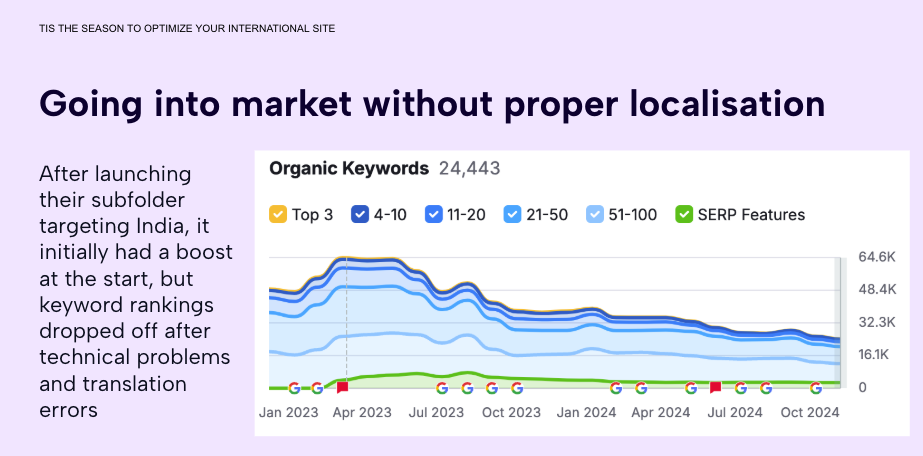
In this example, we can see the long-term drop off in keyword rankings as technical problems and translation errors increasingly confused Google.
3-step summary for website internationalization best practices
Moving into international markets without a proper website strategy in place can have a detrimental effect on search engine rankings — and your business’s bottom line. It might not be immediately noticeable and page rankings may drop off relatively slowly, so you’ll have to closely monitor your results after launching websites for new markets.
Gibson offers the following three steps to embarking on an international site optimization project:
- Understand the business requirements to inform your international website structure and setup.
- Research the target markets suggested to identify the right locations to expand to.
- Don’t neglect the technical website checks and work closely with developers to ensure your new international pages are launched with minimal error and are optimized for SEO.
Using Lumar for hreflang reporting & international website optimization
Lumar’s website optimization platform can be used to audit hreflang implementation across your sites at scale, as well as to identify other website internationalization issues.
Get a Lumar demo to stay on top of your international website optimization efforts.
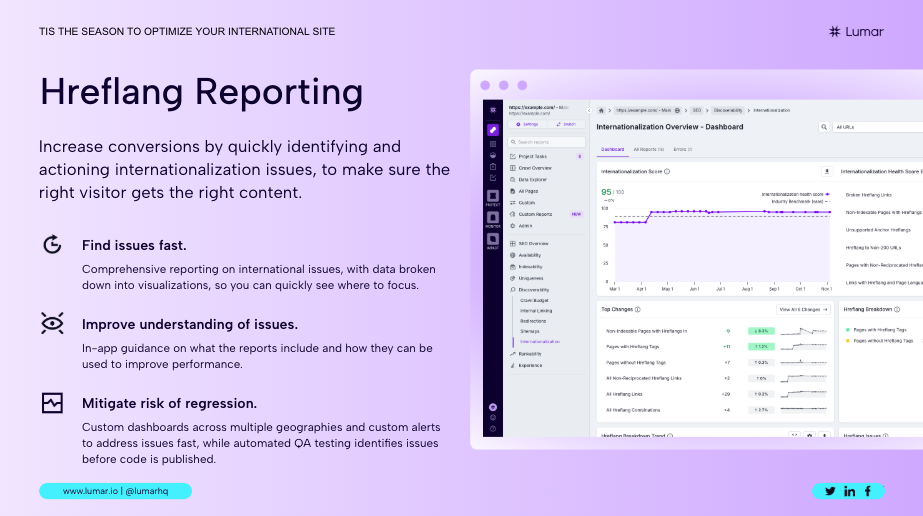

Meet the Webinar Speakers
- Sophie Gibson, Technical SEO Director, StudioHawk
- Rachael Powell, Senior Technical SEO, Lumar
Don’t miss the next Lumar webinar!
Sign up for our newsletter below to be alerted about upcoming webinars, or give us a follow on LinkedIn or Twitter/X to stay up-to-date with all the latest news in website optimization.
Want even more on-demand SEO webinars? Explore the full library of Lumar SEO webinar content.


